Sissi - The Young Empress Blu-ray Movie
HomeSissi - The Young Empress Blu-ray Movie 
Sissi - Die junge KaiserinFilm Movement | 1956 | 107 min | Not rated | No Release Date
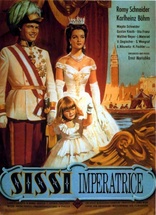
Price
Movie rating
7.1 | / 10 |
Blu-ray rating
| Users | 0.0 | |
| Reviewer | 3.0 | |
| Overall | 3.0 |
Overview
Sissi - The Young Empress (1956)
The second in a trilogy of movies about Elisabeth "Sissi" of Austria, the film chronicles the married life of the young empress as she tries to adjust to formal and strict life in the palace and an overbearing mother-in-law.
Starring: Romy Schneider, Karlheinz Böhm, Magda Schneider, Gustav Knuth, Vilma DegischerDirector: Ernst Marischka
| History | Uncertain |
| Romance | Uncertain |
| Foreign | Uncertain |
| Drama | Uncertain |
Specifications
Video
Video codec: MPEG-4 AVC
Video resolution: 1080p
Aspect ratio: 1.78:1, 1.33:1
Original aspect ratio: 1.37:1
Audio
German: DTS-HD Master Audio 5.1
German: Dolby Digital 5.1
Subtitles
English
Discs
Blu-ray Disc
Single disc (1 BD)
Playback
Region A (B, C untested)
Review
Rating summary
| Movie | 3.0 | |
| Video | 4.0 | |
| Audio | 3.5 | |
| Extras | 0.0 | |
| Overall | 3.0 |
Sissi - The Young Empress Blu-ray Movie Review
Reviewed by Jeffrey Kauffman November 7, 2017Note: This film is available as a part of
The Sissi Collection.
Peter O’Toole will enter the cinematic record books for any number of reasons, including the fact that he remains one of the most Oscar nominated
actors to never receive an “official” award (O’Toole was feted with an honorary Academy Award in 2003, perhaps precisely because he had
never “really” won). O’Toole’s second and third nominations for Best Actor made history in a different way, for in 1964’s Becket and 1968’s The Lion in Winter, O’Toole was playing the same real life historical character (at different ages), King Henry II. There
have been at least a few other performers who have played the same character in different films, and some of them, like Bing Crosby in Going My Way and The Bells of St. Mary's, or Al Pacino, in The
Godfather and The Godfather: Part II, have also
garnered Oscar nominations for each film, like O'Toole, though by and large those performances have been of fictional characters. One of the few
other
times the same performer has played the same real life historical character in otherwise unrelated films was when Romy Schneider "recreated" her
take on Empress Elisabeth of Austria for Luchino Visconti's Ludwig
, years after she had taken on the same role in a series of films that became known as The Sissi Trilogy ("Sissi" was the diminutive
nickname family members called Elisabeth). This in and of itself is kind of a fascinating "trivia" phenomenon, since I personally can't think of
another example where one performer essayed a role based on a real life historical figure in a "series" and then played the same role years later in
a completely unrelated film. There are of course other manifest differences between the series and the Visconti film, due not just to the different
eras in which they were produced, but also due to the fact that Ludwig is an often provocative, even trenchant, entry, while all three
Sissi films tend to exploit a glossy quasi-"Hollywood" style where happily ever after is never too far out of reach.
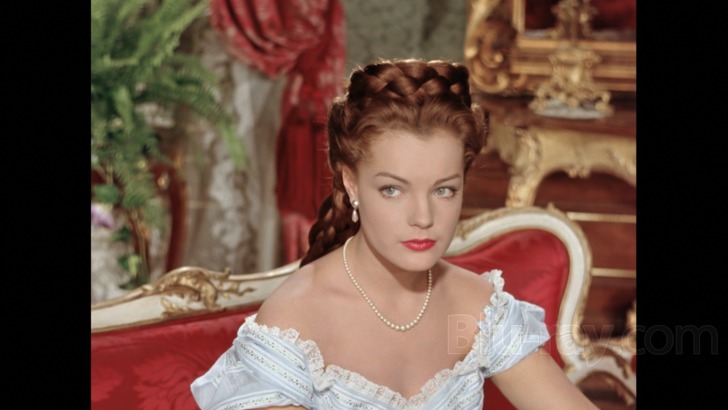
The venerable screenwriter William Goldman (Butch Cassidy and the Sundance Kid) wrote a generally fantastic if occasionally un-PC account of a year on Broadway in The Season, and one of his contentions is that critics and audiences needed to be in the mood for what Goldman termed a “charm show”. Goldman’s paradigmatic example of a “charm show” was a musical that opened just a few months after Sissi debuted, My Fair Lady. Goldman’s contention was that for all its allure, My Fair Lady may not have deserved the rapture with which it was greeted, at least when compared to other shows with similarly strong scores and books which just didn’t “click”, for whatever reason. While I’m not certain Goldman’s hypothesis really stands up to close scrutiny, a cinematic example of it might well be the first Sissi film, which according to a lot of data I read in preparation for reviews of this set indicates the film was one of the hugest hits in the history of German film, despite a kind of routine story. That overwhelming success obviously raised the eyebrows of certain studio bean counters (as overwhelming success so often seems to do), but both of the “sequels” to the original Sissi can almost be seen as veritable remakes of the first film, at least in terms of offering not just many of the same performers playing the same roles, but perhaps more importantly in terms of shoehorning supposed historical events into a structure predetermined by how the first film was organized.
If the first film built its minimal tension out of the relationship between Sissi and her sister, with a little frisson of tension added due to Sissi’s nascent relationship with her future mother-in-law Sophie (Vilma Degischer), Sissi — The Young Empress makes that family dynamic between Sissi and Sophie to focal conflict of this film, with Sissi attempting to adjust not only to her new role as Empress, but perhaps more importantly as a member of Franz Joseph's sometimes problematic family. Sophie is a bit of a control freak, as was hinted at in the first film, but in this second outing she goes so far as to separate Sissi from Sissi’s first born, ostensibly so that Sissi can be more of a helpmate to Franz Joseph (Karlheinz Böhm).
The story here is about as resolutely predictable as in the first film, though it is colored with some interesting “historical” tidbits (including Austria’s ultimate “marriage” to Hungary), and several quasi “set pieces” are obviously meant to evoke memories of the first film. Those include a little visit Sissi takes to visit her more bucolic parents (especially her gregarious father), as well as huge coronation scene capping the film which is obviously designed to mimic the opulent wedding sequence that capped the first film, down to its florid choral soundtrack.
This second film continues to exploit the lovely scenery (including Romy Schneider, some might say) that made the first film visually memorable. There’s “charm” galore in this film as well, but like a lot of fairy tales, there’s a certain shallow aspect that keeps the film from ever resonating very strongly on an emotional level.
Sissi - The Young Empress Blu-ray Movie, Video Quality 
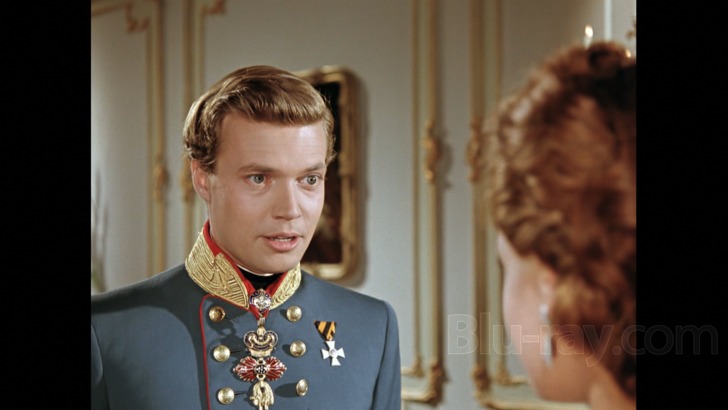
All three of the Sissi films in The Sissi Collection
are presented on Blu-ray courtesy of Film Movement with AVC encoded 1080p transfers in both 1.33:1 and 1.78:1 in what Film Movement is
touting as new 2K restorations (without stating what exactly was the source for the restorations). All three films feature an announcement that they
have been digitally remastered by Arri Film and Television Restoration Services and Taurus Media Digital. Because all three share certain
similarities, I'll deal with them as a group before moving on to comments about each
film separately. Perhaps surprisingly, given the era in which they were shot, all three were evidently originally released in Academy Ratio, despite
the
fact that the "widescreen" rage had already erupted on this side of the pond. Therefore, most of the screenshots I've included with each review
feature
that aspect ratio, but I have also included a few of the "rejiggered" 1.78:1 versions so that those interested can see the differences in framing. One
of
the most noticeable differences is not in fact with regard to framing but with regard to the appearance of grain, which is much more substantially
noticeable in the 1.78:1 versions, I assume due to being blown up and cropped to fit that aspect ratio. All three films were shot using the German
Agfacolor process, a technique that is manifestly different looking than "classic" Technicolor. If "Technicolor reds" might be thought of as one of the
defining characteristics of that technology, I'd argue that "Agfacolor blues" might be a corollary for this particular process. Otherwise, Agfacolor can
look just a little anemic, at least relative to Golden Age Technicolor, with reds tending to skew a bit toward the pink or orange side of things and the
overall palette never looking quite as richly suffused as in traditional Technicolor outings. The restorations are by and large quite winning, though
eagle
eyed viewers may still catch a stray (minor) blemish or two that peeks through now and again. Detail levels are a little variable, with all three films
looking a bit on the soft side. At times even midrange shots tend to look a bit "blurry" in terms of things like facial details. That said, in close-ups,
fine
detail on elements like the opulent costumes and sets can be excellent. While there is a fine grain field in the 1.33:1 versions, things look just
slightly
digital to my eyes, with perhaps some high frequency filtering having been applied, since the grain field is somewhat variable and tends to look
unnatural at times.
The second film's credit sequence looks at least a bit more natural than what I discussed in the Sissi Blu-ray review, and both densities and general suffusion are arguably more consistent in this presentation as well.
There are some rather vivid hues on display here (at least in the relative context of Agfacolor), with Sophie's lush blue gown in a ballroom scene
rather memorable, and several examples of green, including what looks like a satin gown for Sissi, looking nicely radiant. There are occasional
variances in clarity here, including what may be a few uses of stock footage in a mountain climbing scene later in the film. This transfer has just a
few more (again, rather minor) vertical scratches on display than the first film does.
Sissi - The Young Empress Blu-ray Movie, Audio Quality 
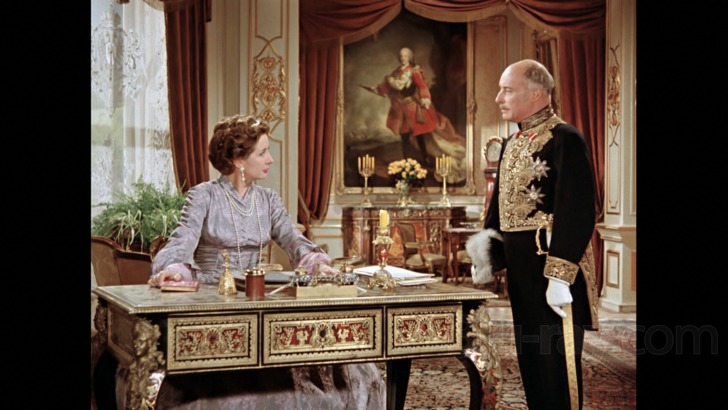
All three of the Sissi films feature DTS-HD Master Audio 5.1 and Dolby Digital 5.1 mixes in the original German. Why these have not been offered with the original mono tracks is unfortunate, since aside from some age related issues like overall boxiness, there are recurrent prioritization issues in all three films that sounded decidedly unnatural to my ears. For example, sound effects like squawking geese or galloping horse hooves can occasionally overwhelm dialogue. The "surround" activity in these mixes is intermittent at best and at worst tends to add too much reverb (for my ears, anyway), leading to a somewhat diffuse sound. There is minor distortion in all three films with regard to some of the music, especially in terms of the more blaring brass or higher string sounds. Dialogue generally comes through fine, with the exception of the aforementioned prioritization issues.
Sissi - The Young Empress Blu-ray Movie, Special Features and Extras 
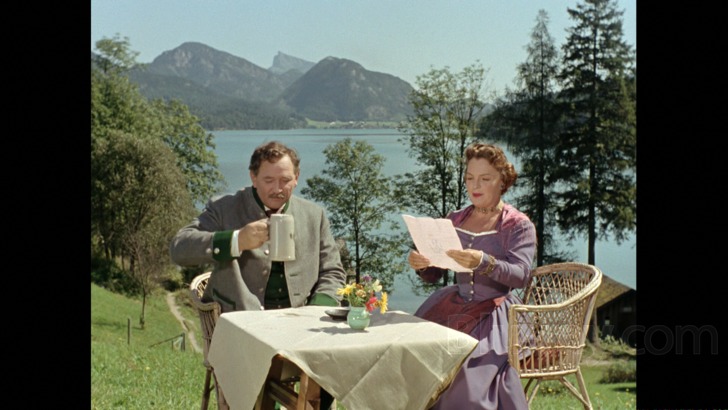
While there are some supplements included in this package, none are on this particular disc. See our The Sissi Collection Blu-ray review for details.
Sissi - The Young Empress Blu-ray Movie, Overall Score and Recommendation 
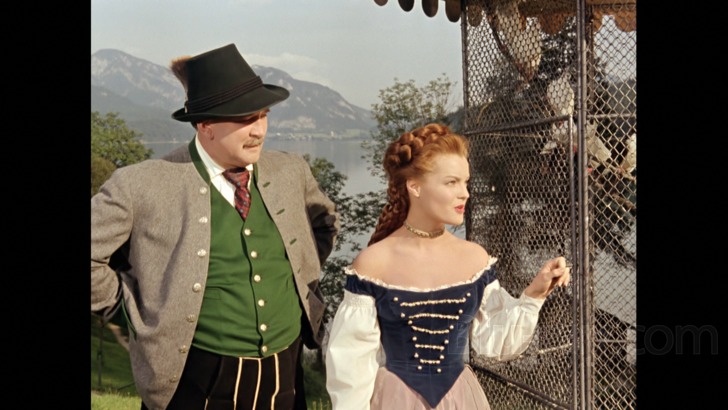
Sissi — The Young Empress could have used a little more innovation in its storytelling, since it's obvious that the filmmakers wanted to recreate the first film as much as possible. But that's not an entirely bad thing, since this film, like its progenitor, offers scenery galore and an undemanding story that moves toward its happy ending without too much trauma. As with the other films in this set, there are occasional technical hurdles to overcome, but Sissi — The Young Empress comes Recommended.
Similar titles
Similar titles you might also like
(Still not reliable for this title)

Sissi – Fateful Years of an Empress
Sissi - Schicksalsjahre einer Kaiserin
1957

Sissi
1955

That Hamilton Woman
Lady Hamilton
1941

A Royal Affair
En kongelig affære
2012

Saraband for Dead Lovers 4K
Saraband | Indicator Series | Limited Edition
1948

Antony and Cleopatra
Limited Edition to 3000
1972

Queen Margot
La Reine Margot | 20th Anniversary Director's Cut
1994

The Crown: The Complete Sixth and Final Season
2023

The Sword with No Name
Bool-kkott-cheo-reom na-bi-cheo-reom
2009

War & Peace
2016

Cleopatra
1934

The Leopard
Il gattopardo / Italian and American Versions
1963

The Scarlet Empress
1934

Frantz
2016

The Concubine
Hoo-goong: Je-wang-eui cheob | Limited Edition
2012

Queen Christina
Warner Archive Collection
1933

Senso
Italian and English Versions
1954

Othello
The Tragedy of Othello: The Moor of Venice / 1952 and 1955 versions
1951

The Young Victoria
2009

Portrait of a Lady on Fire
Portrait de la jeune fille en feu
2019